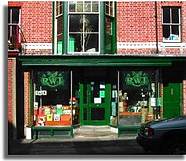
Civic and Community
A Day in the Life of a chairman of Radnorshire Wildlife Trust
 |
I got up and dressed at 6.30am. It was just getting light. I am a bird ringer. I put up a mist net in my wildlife friendly garden in order to trap a few birds so that I could ring them. The dawn was hazy -good because the birds don't see the mist net. My mist net is about 3 metres high and 12 metres long. It is constructed of soft black nylon netting with meshes about 25Omm square, held on two upright poles with horizontal strings between the poles supporting the netting. The birds fly into the net and are gently caught in the meshes, they lie in a pocket in the net as if resting in a hammock. I extracted the birds from the net and put a tiny metal ring on one leg of the bird; the ring has a number on it giving the bird a unique identification number. In my note book, I recorded this number, the species of bird, its age, sex, wing length, weight, the time, date and place of capture at Nant Glas- a small hamlet near Rhayader (Grid reference SN 994649).
Between 7.00am and 9.00am I trapped four birds -a house sparrow, dunnock, greenfinch, great tit and blue tit. At 9.00am the sun was brilliant and illuminating the net so that the birds saw it and avoided it, so I took the net down. I put the data that I had recorded in my field note book, into my computer and sent it via email attachment to the British Trust for Ornithology. The BTO collects all the data from bird ringers around the UK. The data provides information on the status of bird populations which is vital for the conservation of bird species. Of the species which I ringed, the House Sparrow, once such a common bird is now so depleted in numbers that it is on the danger list -in need of vital conservation support, if it is to survive. 100 years ago no-one would have believed this possible. Changes in land management such as farming practices are responsible for this. Ringing data like mine, , contributed by ringers all over Wales will help to solve the reasons for this decline, but it is organisations such as the Radnorshire Wildlife Trust who will help to halt the decline and provide conditions for the recovery of this species and many other species.
 |
|
Offices of the Radnorshire
Wildlife Trust in Llandrindod Wells
|
 |
|
Gilfach
Nature Reserve, near Rhayader
|
My next destination was the office of the Radnorshire Wildlife Trust in Llandrindod Wells. I am Chairman of R WT and I had to make a visit to the office to attend to administrative business such as arrangements for the Annual General Meeting, applications for the post of Administration Manager, advertisements for the Barnes Memorial Lecture by Chris Gomersall. (D A Barnes was a conservationist who lived in Llandrindod Wells and died in 1982 aged 67 years). All of this administration is essential to the furtherance of the aims of the Radnorshire Wildlife Trust which are : To conserve plants and animals in their native habitats by establishing Nature Reserves and advising landowners on managing their land to improve it for wildlife.
Early afternoon,
I visited Gilfach Nature Reserve which encompasses some of the River Marteg
valley and surrounding hills - 418 acres of land which has escaped most of the
agricultural intensification of the last 40 years and is now farmed organically.
Unfortunately the bridge over the River Marteg is being repaired
so I was unable to visit the longhouse and barn which are now a holiday house
and a visitor centre. This Radnorshire Wildlife Trust Nature Reserve is about
3 mile north west of Rhayader.
Between these activities, I was out photographing activities in Rhayader and
Llandrindod Wells for A Day in the Life Digital Project.